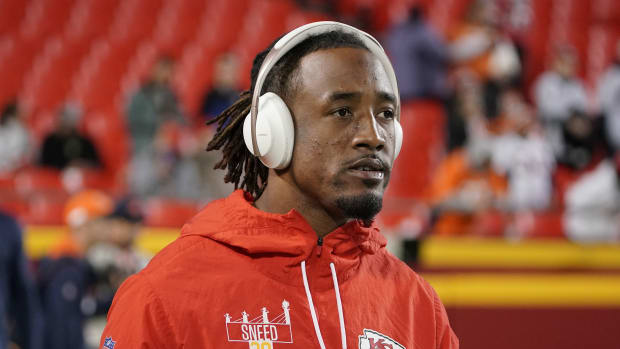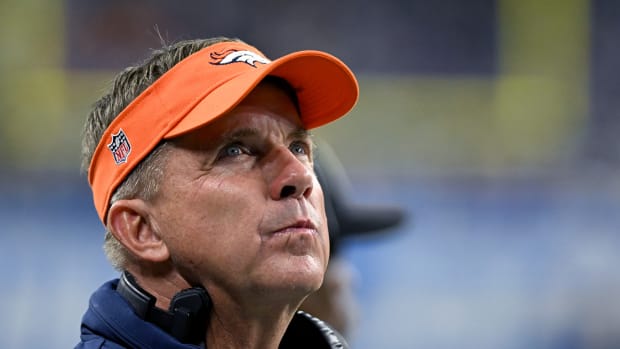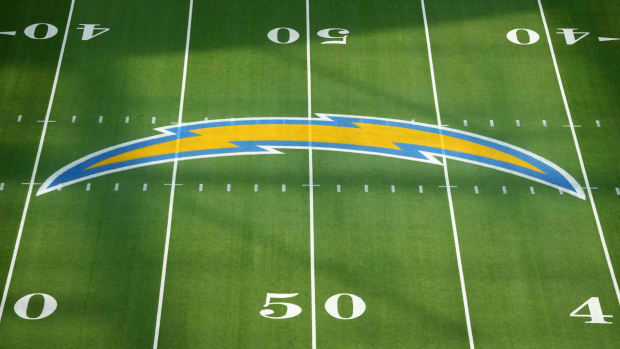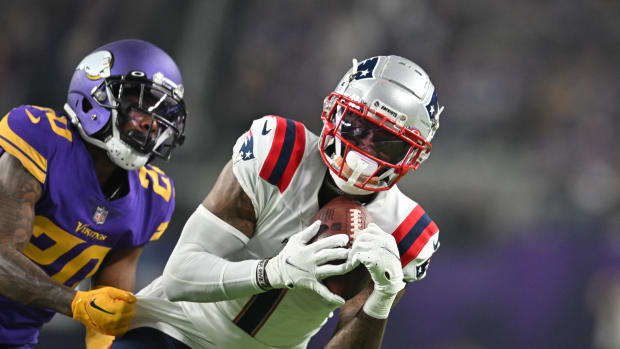
Giants Preview: Fast, New System for Eli and Crew
OFFENSE
After 10 years, the New York Giants brass decided their offense had become like a bag of chips left open for two weeks. It’s hard to say what, exactly, made head coach Tom Coughlin and GM Jerry Reese recognize its staleness. It could have been a running game that’s been in subtle decline and fell to 29th in the league last season. Maybe it was an offensive line that hasn’t seemed to be on the same page since the team’s second unlikely Super Bowl run. Perhaps it was Eli Manning’s league-leading 27 interceptions, 15 of which came during an 0–6 start (the most the league had seen over the first six weeks since Dan Fouts threw 16 in 1986). Or, maybe it was the fact that a third of Manning’s interceptions were not actually his fault, but rather, a consequence of wide receivers running incorrect routes.
Whatever it was, the Giants recognized a need for change. Sixty-two-year-old offensive coordinator Kevin Gilbride was politely ushered into retirement and 37-year-old Ben McAdoo, an assistant in Green Bay for eight seasons (coaching tight ends for six and quarterbacks for two), was brought in to replace him.
This is the first time since his rookie season in ’04 that Eli Manning is learning a new system. For a cerebral quarterback like the two-time Super Bowl champion, it can be a reenergizing process. Manning has said as much.
As for what the new system entails: for starters, fast tempo. McAdoo understands the trends of today’s NFL and sees the huddle going the way of the fullback. Speaking of fullbacks, the system, though modern, will still employ one, just like McAdoo’s Packers did with John Kuhn. Either perennial Hard Knocks star John Conner or fourth-year mainstay Henry Hynoski will do work in the staple two- and sometimes three-man backfield packages.
Conner and Hynoski will be ancillary contributors, though, as the bulk of the system can be characterized as a “West Coast spread.” This means a heavy dose of shallow and intermediate timing-based wide receiver routes (especially slants), which Manning can thrive. And—here’s the spread element—you’ll occasionally see backs and tight ends split out and running the same outlet patterns that they’d normally have run from the backfield.
Ben McAdoo is revamping the Giants offense, and wideout Reuben Randle will play a major role in the new scheme. (Seth Wenig/AP)
This means more empty sets, of course. Empty sets can put a strain on pass protection, as there are no support blockers to help the five offensive linemen. But more often, the strain is actually placed on the quarterback, who must be disciplined in his three-step timing and alert for any blitzers the five-man line can’t mathematically account for. Manning won’t have a problem here, assuming he doesn’t yield too often to the intrinsic devil on his shoulder that implores him to take chances in hopes of making something happen.
When the Giants aren’t in empty, expect McAdoo to help his O-line with chip-blocking tight ends and backs, just like he saw his former bosses—Mike McCarthy, Joe Philbin and Tom Clements—do to overcome Green Bay’s iffy front five.
The Giants are a little more talented up front than some of those Packer squads, but they’re far from outstanding. Left tackle Will Beatty had a maddeningly up-and-down 2013 campaign. When he struggled he did so mightily, especially in pass protection. He missed some of offseason activities while recovering from a broken leg, so for insurance the Giants brought in disappointing ex-Saints second-rounder Charles Brown, and also gave backup guard James Brewer some OTA reps outside.
At right tackle, 2013 first-rounder Justin Pugh found out the hard way last year that he needs to get stronger, particularly in his lower body. He’s added 10 pounds of muscle this offseason, though that’s only half the challenge: He must maintain the weight during the grind of autumn. No matter what he weighs, Pugh will at least continue to benefit from steady improvements in technique.
Inside, Geoff Schwartz was signed to replace Kevin Boothe at left guard. Schwartz doesn’t have ideal lateral athleticism (which can make it difficult to get consistent movement in the ground game), but he was very solid as an unlikely starter for the Chiefs last year. At right guard, with Chris Snee’s retirement, John Jerry steps in. It’s possible Jerry, who had a tumultuous career with the Dolphins, will be pushed by 2012 fourth-round pick Brandon Mosley. At center will likely be 2014 second-round pick Weston Richburg. He must beat out former Bronco J.D. Walton, who has missed virtually the last two seasons because of a severe ankle injury.
THE MMQB: Weston Richburg isn't in Kansas anymore
In today’s quick-passing NFL—and in McAdoo’s three-and five-step timing system—you don’t need a great offensive line, you just need one that’s not awful. What really makes the difference is having playmakers in the passing game. Jerry Reese recognizes this and spent a first-round pick on Odell Beckham Jr., who will replace unreliable former first-rounder Hakeem Nicks. Beckham has the speed and quickness, showing run-after-catch effectiveness at LSU. Reliable hands and an understanding of route running should allow him to contribute right away.
Beckham’s arrival allows Victor Cruz to keep playing the slot, where he’s most lethal. Cruz has outstanding wiggle and body control to create separation late in routes, making him Manning’s favorite target when things break down. At the other receiver spot will be Beckham’s former LSU teammate, Rueben Randle. The 2012 second-round pick is a hands-catcher with natural athleticism. After a slow start to his career he flashed playmaking ability last season, though there were still far, far too many cases where he and Manning weren’t on the same page. In McAdoo’s system, Randle has a chance to become the Jordy Nelson. Also contributing will be Jerrel Jernigan, who had a great offseason and seems to be well-suited for the new scheme. When you factor in the return of Mario Manningham, this is a potentially terrific receiving corps.
But the downside is it’s not complemented by a quality tight end. That hurt the Giants last season, too, when they relied on the thoroughly mediocre Brandon Myers. This year, they’re hoping to get by with scantly experienced 2012 fourth-rounder Adrien Robinson or 2012 undrafted man Larry Donnell. They also have veteran journeyman Kellen Davis, who can block but not run.
Nothing, however, masks weaknesses like a great quarterback. The Giants have one in Manning. Or, they have one capable of exhibiting great traits, at least. Manning is one of the gutsiest, savviest true pocket passers in the league, with an outstanding ability to make strong-arm throws just before absorbing a hit. Like any passer he’d benefit from a solid running game, which the Giants hope free agent pickup Rashad Jennings can provide. Jennings consistently created yards after contact with the Raiders and, though he’s somewhat of a bruiser at 6-1, 235 pounds, he’s surprisingly proficient running out of shotgun—something McAdoo’s Packers clubs thrived doing with similar backs.
Behind Jennings there are two similar runners in Peyton Hillis and fourth-round rookie Andre Williams. Unfortunately, neither has proven quickness or explosiveness, which is what David Wilson, who was recently waived with a career-ending spinal condition, was supposed to provide.
DEFENSE
Dominique Rodgers-Cromartie leads what the Giants need to be an improved secondary. (Julie Jacobson/AP)
A declining pass rush has resulted in a declining defense in New York, in large part because it has exposed a mediocre secondary. To fix this, Jerry Reese, who normally covets dominant pass-rushers, revamped his secondary instead. The Giants signed Dominique Rodgers-Cromartie for five years, $35 million ($14 million guaranteed), ex-Seahawk Walter Thurmond for one year at $3 million and, for depth purposes, drafted late-rounders Nat Berhe and Bennett Jackson. The rookies might have a tough time even making the roster considering they’re competing with 2012 third-round pick Jayron Hosley and last year’s fill-in starter, Trumaine McBride, who performed quite admirably.
Rodgers-Cromartie gives the Giants a quality man-to-man corner, something their typically matchup zone-based defense has not had since Jason Sehorn. DRC will team with 2011 first-rounder Prince Amukamara who, contrary to popular belief, is coming off a stellar season. Thurmond, despite having missed most of the previous two years with a leg injury, hardly missed a beat last year, resuming his ascension to the top of the NFL’s slot corner list. He instantly upgrades this position.
At safety, sturdy playmaker Will Hill took a sledgehammer to his budding career after violating the league’s substance abuse policy for a third time and getting released. Stevie Brown (coming off a torn ACL), an intriguing playmaker in his own right, will assume the starting duties alongside Pro Bowl caliber utility man Antrel Rolle.
The additions of Rodgers-Cromartie and Thurmond suggest the Giants are not overly optimistic about a resurgence from their four-man pass rush. Man corners translate to increased blitzing, something coordinator Perry Fewell has done more often in recent years.
Blitzes or no blitzes, the Giants need Jason Pierre-Paul to bounce back from an injury-slowed season and regain the dominant form he showed in 2012. With the aging Osi Umenyiora and Justin Tuck departing in free agency over the last two offseasons, Pierre-Paul is, save for pass-rushing specialist Mathias Kiwanuka, the only remnant of what was once The NASCAR Front.
The hope is that Damontre Moore, who was disappointingly immature as a third-round rookie last season, can fill Tuck’s old role as a weakside defensive end. If he can’t, then underrated free agent pickup Robert Ayers will get a crack.
Inside, 2013 second-rounder Johnathan Hankins is expected to step up alongside quick-handed veteran Cullen Jenkins. But to push Hankins, Reese spent a third-round pick on Jay Bromley, a 305-pounder from Syracuse who will initially handle backup duties with veteran Mike Patterson.
GIANTS CAMP REPORT: Peter King on the new-look offense
Linebacker has never been a particularly important piece of New York’s puzzle, and that won’t change. Middle backer Jon Beason regained some of his pre-injury Pro Bowl form after joining the club midway through last season. He broke his foot during OTAs, but could be back on the field in time for Week 1. Even if Beason’s durability isn’t an issue, there’s still the mediocrity of outside backers Jameel McClain, Spencer Paysinger and pass-defending specialist Jacquian Williams to overcome.
SPECIAL TEAMS
Josh Brown was successful on 23 of 26 field goal attempts last season and can be trusted under pressure. Opponents averaged 13.6 yards per return off Steve Weatherford punts, fourth-most in the league. A rash of injuries compromised the team’s depth, however, so, barring a recurrence of that, the problem may naturally be fixed with more talented backups filling the punt coverage unit. For the return game, the Giants signed boom-or-bust mighty mouse Trindon Holliday.
BOTTOM LINE
Wearing rose-tinted glasses, this looks like a nine-, maybe 10-win team, which in past years has been enough to set up an unlikely but convincing Super Bowl expedition. If the new offensive system clicks and the running game components finally stay healthy, the Giants’ offense can make up for a defense that has a chance to be no better than good.







































